NGC 6946 & NGC 6939
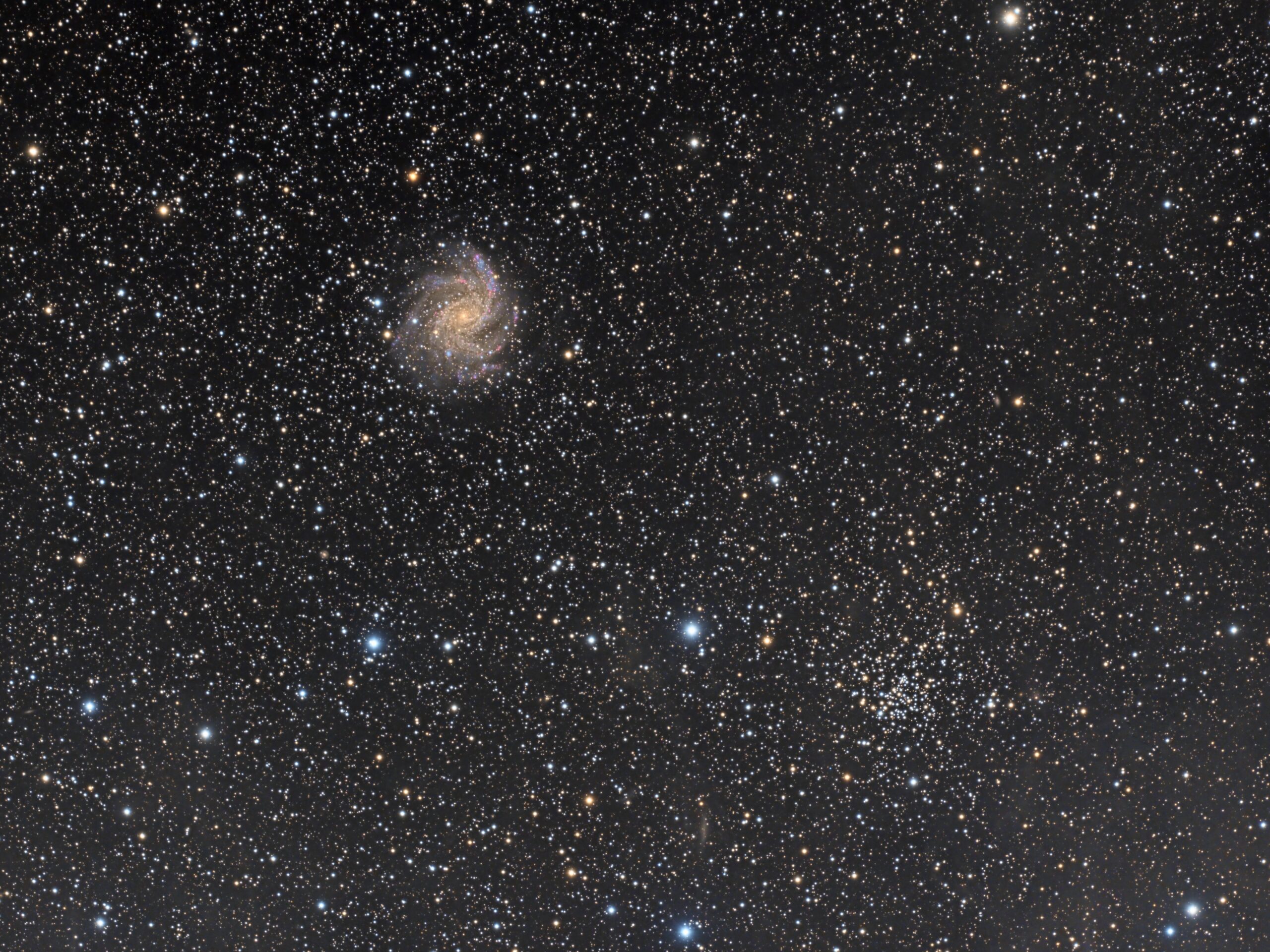
Click image for full size version
January 24, 2021
The two objects in this image each cover about 1/3 of the Moon’s diameter, but one lies about 6,000 times further away from us than the other. Open cluster NGC 6939 (lower right) lies within the Milky Way, our home galaxy, about 3,860 light years away. Galaxy NGC 6946 (upper left), the Fireworks Galaxy, is at around 22 million light years distant. Every star visible in this image is in our galaxy, or in other words, in the foreground.
It’s easy to see why NGC 6946 (upper left) is nicknamed the Fireworks Galaxy. The reddish star-forming regions are similar to the Orion Nebula in our own galaxy. We see NGC 6946 face on, so it’s possible to spot the dark dusty lanes between the blue arms full of stars, and within the golden centre. In addition to looking like a fireworks display, this galaxy has acted like one: there have been 10 supernova explosions observed in it since 1917, most recently in 2017. It would appear brighter if it wasn’t heavily obscured by our own galaxy’s dust lane. There’s likely a black hole gobbling up stars concentrated in the bright core of the galaxy.
NGC 6939 sparkles with a slightly reddish overall hue due its extreme age of 2.2 billion years. Most of its blue and white stars have exhausted their fuel and are no longer visible. I’ve glimpsed this open cluster in binoculars, and it is lovely in a telescope of any size. It is about 3,860 light years away.
This image includes a lot of Integrated Flux Nebula — reflections off dust and soot of the combined glow of the Milky Way’s stars. You can see this diffuse glow throughout the image, especially the bottom left, where it is brightest. Careful processing was required to avoid inadvertently obliterating this dust during processing.
One of my previous images of this region was the Space.com Image of the Day on October 12, 2018.
Tekkies:
Acquisition, focusing, guiding and control of Paramount MX mount with TheSkyX. Focus with Optec DirectSync motor and controller. Automation with CCDCommander. Equipment control with PrimaLuce Labs Eagle 3 Pro computer. All pre-processing and processing in PixInsight. Acquired from my SkyShed in Guelph. Average or better transparency and seeing. Data acquired October 9 – December 6, 2020.
Luminance: Sky-Watcher Esprit 150 f/7 refractor and QHY 16200-A camera with Optolong UV/IR and H-alpha filters
Chrominance: Takahashi FSQ-106 ED IV @ f/5 and QHY367C Pro one-shot colour camera with Optolong UV/IR filter
Luminance: 37x10m = 6hr10m
H-alpha: 14x10m = 2hr20m
Chrominance: 114x5m = 9hr30m
Total: 18hr00m
Data Reduction and Initial Processing
Preprocessing: The WeightedBatchPreProcessing script was used to create Luminance and H-alpha master frames (from the mono camera) and Drizzle files (from the one-shot colour camera). DrizzleInegration with CFA Drizzle was used to integrate the OSC drizzle files with 2x scaling.
Registration of RGB to Luminance master: The RGB master was registered to the Luminance master using ImageRegistration.
Gradient Removal: DBE was applied to Luminance, H-alpha and RGB masters using Subtraction.
Colour
Colour Balancing: Colour of the RGB master was balanced with PhotometricColorCalibration.
Linear Noise Reduction: MultiscaleLinearTransform was used to reduce noise in the background areas, using an internal mask to protect bright structures. Layer settings for threshold, strength and iterations were as follows: Layer 1: 5.0 0.85, 1 iteration; Layer 2: 3.5 0.75, 1 iteration, Layer 3: 2.0, 0.5, 1 iteration.
Stretching: HistogramTransformation was applied to make a pleasing, bright image, with background set to an intensity of approximately 0.10.
Luminance
Deconvolution: A star mask was made from the Luminance master to use as a Local Deringing Support Image. A copy of the image was stretched to use as a range mask. Deconvolution was applied (100 iterations, regularized Richardson-Lucy, external PSF made using the PSFImage script; Global dark deringing = 0.03).
Linear Noise Reduction: MultiscaleLinearTransform was used to reduce noise in the background areas of the Luminance-filtered image, using an internal mask to protect bright stars. Layer settings for threshold, strength and iterations: Layer 1: 5.0 0.85, 2 iteration; Layer 2: 3.0, 0.75, 1 iteration; Layer 3: 1.5, 0.25, 1 iteration.
Stretching: HistogramTransformation was applied to make a pleasing, bright image, with background set to an intensity of approximately 0.10.
H-alpha
Deconvolution: A star mask was made from the H-alpha master to use as a Local Deringing Support Image. A copy of the image was stretched to use as a range mask. Deconvolution was applied (50 iterations, regularized Richardson-Lucy, external PSF made using the PSFImage script; Global dark deringing = 0.02; Global light deringing 0.003).
Linear Noise Reduction: MultiscaleLinearTransform was used to reduce noise in the background areas of the H-alpha image. Layer settings for threshold, strength and iterations: Layer 1: 4.0 0.85, 1 iteration; Layer 2: 3.0, 0.75, 1 iteration; Layer 3: 2.0, 0.25, 1 iteration.
Stretching: HistogramTransformation was applied to the H-alpha to make a pleasing, bright image, with background set to an intensity of approximately 0.10.
Combining Luminance, Colour and H-Alpha Images
Creation of LRGB: The Luminance was applied to the RGB image using LRGBCombination with default settings.
Creation of HaLRGB: ColorSaturation was applied to the image to boost reds and blues in the galaxy using a mask made from a clone of the H-alpha image.
Additional Processing
Nonlinear Noise Reduction: TGVDenoise was used in L*a*b* mode to reduce noise with a mask used to target the background areas and protect the stars and nebula (max. 1,000 iterations and convergence selected for both lightness and chrominance).
Contrast Enhancement: LocalHistogramEqualization was applied with scales of of 17 and 35 (max contrast 1.5, strength 0.25, 1 iteration), followed by a scale of 135 (max contrast 1.5, strength 0.25, 1 iteration).
Sharpening: MultiscaleLinearTransform was used to sharpen Layers 2 and 3 with strengths of 0.1 and 0.2, respectively. A mask was used to select only bright features in the galaxy for sharpening.
Final Steps: Background, galaxy and star brightness, contrast, and colour saturation were adjusted in several iterations using CurvesTransformation with masks as required. ICCProfileTransformation (sRGB IEC61966-2.1; Relative Colorimetric with black point compensation) was applied prior to saving in jpg format.

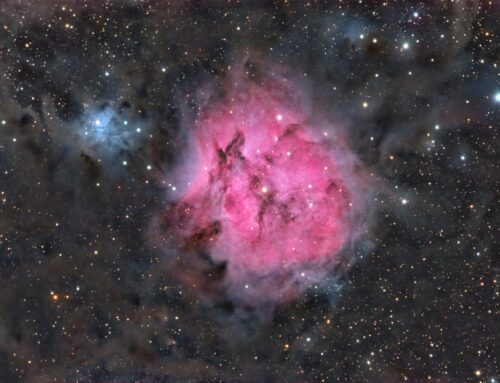

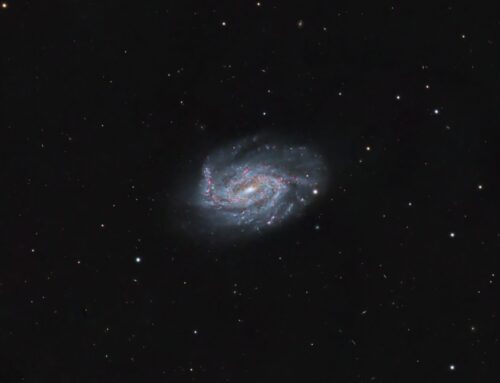
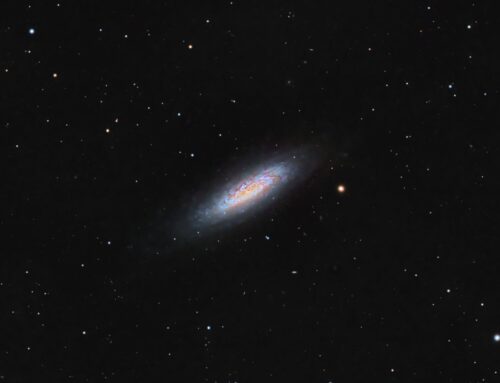
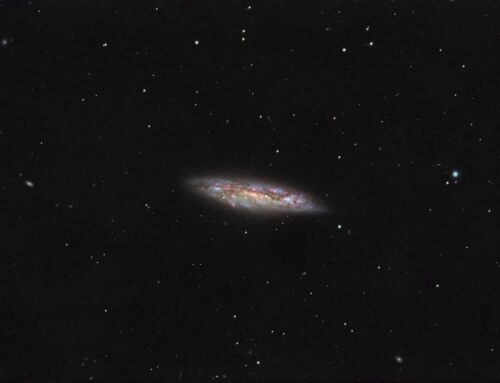
Absolutely beautiful.
You really captured a lot of the faint arm detail in this one, nice job keeping the flux during processing. Nice image!!